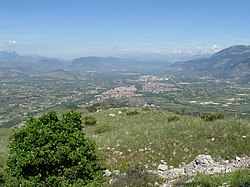Valle Peligna
- View a machine-translated version of the Italian article.
- Machine translation, like DeepL or Google Translate, is a useful starting point for translations, but translators must revise errors as necessary and confirm that the translation is accurate, rather than simply copy-pasting machine-translated text into the English Wikipedia.
- Consider adding a topic to this template: there are already 3,026 articles in the main category, and specifying
|topic=will aid in categorization. - Do not translate text that appears unreliable or low-quality. If possible, verify the text with references provided in the foreign-language article.
- You must provide copyright attribution in the edit summary accompanying your translation by providing an interlanguage link to the source of your translation. A model attribution edit summary is
Content in this edit is translated from the existing Italian Wikipedia article at [[:it:Valle Peligna]]; see its history for attribution. - You may also add the template
{{Translated|it|Valle Peligna}}to the talk page. - For more guidance, see Wikipedia:Translation.

The Valle Peligna, also known as Conca di Sulmona, is a plateau in central Abruzzo, southern Italy, included in the province of L'Aquila. It has a surface of some 100 km2.
The valley takes its name from the Paeligni. In prehistoric times, it was occupied by a lake which disappeared after a series of earthquakes approximately 300,000 years ago, leaving the land full of marshes but fertile.[citation needed] The former barrier between the lake and the sea was in what are now the gorges of Popoli. Three hills near Sulmona are the relics of the single island in the lake.
The valley is crossed by the rivers Aterno and Sagittario. In addition to Sulmona, the main centers in the plateau include Raiano, Vittorito, Corfinio, Pratola Peligna and Pacentro.[citation needed]
Historically, it was inhabited by the Paeligni, an Oscan tribe.
42°04′49″N 13°53′16″E / 42.08028°N 13.88778°E / 42.08028; 13.88778












